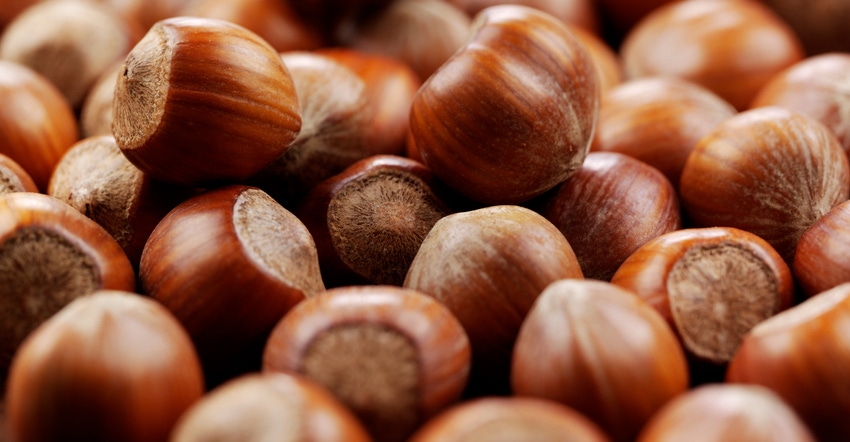
A long-term hazelnut tree investment made by Oregon producers is paying off in a big way, with a new record for 2020.
Hazelnut trees were first planted in Oregon in the mid-1850s. Fast-forward to this year’s anticipated hazelnut crop — a Subjective Yield Survey expected record yield for hazelnuts in Oregon, initially predicted to total 59,000 tons — nurtured and harvested by a thousand grower families in the Willamette Valley region.
According to the Oregon hazelnut industry webpage, oregonhazelnuts.org, this is the right place to grow the filberts. “Oregon boasts an ideal climate for high-quality hazelnuts. It’s in this special corner of the world where temperate ocean, mountain and river climates meet rich volcanic soils to create prime hazelnut-growing country.”
Despite the optimism, the Hazelnut Marketing Board stressed the early Subjective Yield Survey was only a guesstimate and not an exact science. “The results of the survey should be viewed as an approximation, not a guarantee,” HMB members wrote.
Good thing, too, because those earlier projection numbers got left behind in the harvest dust. That initial rosy anticipation got even rosier with the latest release of the USDA National Agricultural Statistics Service Objective Final Yield survey data, which showed a revised expectation of 71,000 tons. If those numbers, based on 60,000 bearing acres, turn out to be on target, this would be a 61% increase from last year’s crop.
Quantity and quality
Statistics released by the HMB show a laboratory analysis of percentage of good nuts at 88%, with average dry weight per good nut at 3.2 grams. The number of nuts picked per tree this year is 264, compared to 201 in last year’s harvest.
NASS reported that large nuts in sizes 4, 5 and 6 represented 37% of total good nuts, while the larger jumbos — sizes 7 and 8 — accounted for 43% of the total.
HMB isn’t surprised at the better-than-expected results. Established in 1949 by growers and handlers, and funded by a per-ton assessment to handlers, the board sets quality standards and funds hazelnut promotion.
Reflecting on an annual yield that continues to trend upward as new trees reach bearing age, Juli Jones, HMB grower relations director, says: “We’ve been anticipating a spike in yield as acreage has tripled over the past decade, and thousands of those new trees are reaching nut-bearing status.”
A grower survey showed trees still in their first decade were producing about 1,600 pounds per acre, while older trees (11 years and older) were bringing in 2,600 pounds per acre. These numbers bode even more optimistically for future record breaking: Hazelnut trees, which bloom and pollinate in the middle of the winter, can produce for well over 100 years.
A simpler harvest
Hazelnut growers have some advantages over other tree nut growers — like those who raise almonds, walnuts, pistachios or pecans — in that when mature, hazelnuts don’t have to be shaken from their trees. Mother Nature does most of the work, and the nuts drop off naturally, to be swept into windrows and vacuumed up by a harvester that deposits them in 1,300-pound wooden crates.
Christian Richmond, a third-generation grower and manager of 700 acres of nut trees at Newburg’s Star Mooring Farm and Oregon Hazelnut Orchards, says, “Our growing methods have improved, and more trees are coming online. In 2013, when the price of hazelnuts almost doubled, a lot of Willamette Valley grass seed farmers decided to jump on that bandwagon and plant a few hundred acres of hazelnut trees that take six to seven years to maturity.
“Since that time, some 5,000 acres a year have had trees planted, and now we’re seeing that expected jump in production. Over the next couple of years, those new trees should reach their full maturity and start producing upwards of 3,000 pounds per acre.”
All of which means that even rosier days may lie ahead. “These increased numbers mean we can get on track with some larger companies like Nestles, Post, General Mills, Mars and Snickers, and start seeing hazelnuts in cereal and candies,” Jones says.
“We lost the China market when tariffs were imposed, but I believe we’ll eventually get that market back. In the meantime, our domestic market continues to climb … and that future looks bright.”
Allen writes about the West from Tucson, Ariz.
About the Author(s)
You May Also Like




